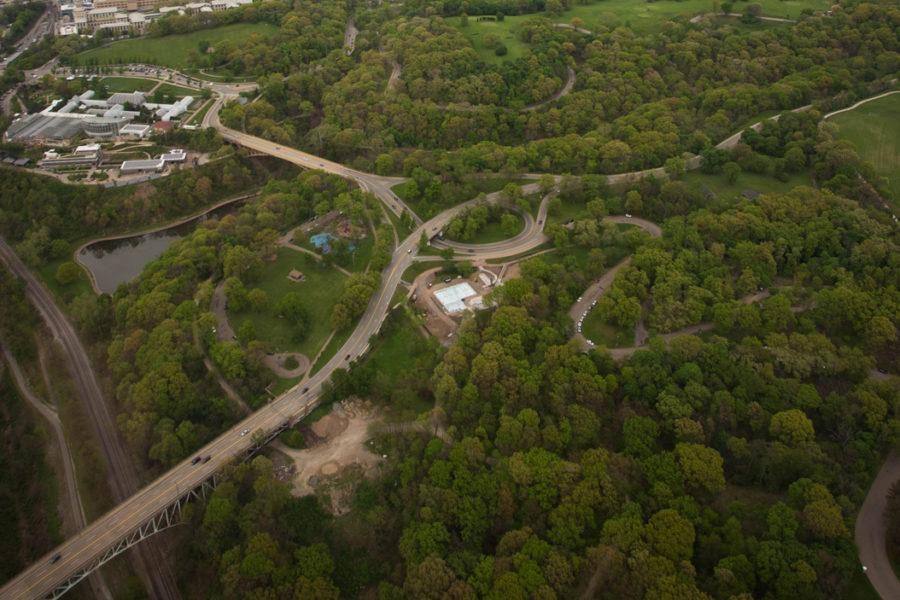Touch grass: How to get the most out of Pittsburgh’s parks


Schenley Park, pictured, is the closest park to Pitt’s campus, just a five-minute walk from the Cathedral of Learning. The park has hiking and biking trails, disc golf courses and an outdoor ice skating rink in the winter months.
Pitt’s urban campus gives students plenty to do around Pittsburgh, but all the concrete, steel and stifling city air can weigh on students’ mental health.
A 2019 study in Science Advances found that contact with nature positively impacts cognitive functioning and emotional wellbeing. Luckily, Pittsburgh offers ample opportunity for its residents to reap the benefits of the outdoors with 165 parks of varying size. But if a walk in nature only comes once in a while, it’s important to make the most of your park going experience.
Schenley Park is the closest to Pitt’s campus, just a five-minute walk from the Cathedral of Learning. The park has hiking and biking trails, disc golf courses and an outdoor ice skating rink in the winter months.
Rylee Schwee, a rising junior economics major, spent about an hour and a half in Schenley Park almost every morning this past year. As an ultra runner — someone who runs distances further than a marathon — she said she enjoys the park’s looping running trails.
“I chose to go to Pitt partly because of the outdoor spaces, like access to trails,” Schwee said. “And all last year, it really helped me during the pandemic.”
Beyond the usual hiking, biking and picnicking, some students use Pittsburgh’s greenspaces in hopes of encountering rare birds. Garret Sisk, president of the Birdwatching and Ornithology club, leads students on birdwatching outings and helps them identify species they see on their own.
The club usually spends its first birdwatching outing of the year at Schenley. Sisk, a rising junior environmental engineering major, said although that park isn’t the best birdwatching spot in the City, its proximity to campus makes it an accessible spot for newcomers.
“We have generally one Schenley Park outing as kind of the intro outing, because it’s super accessible to Pitt students,” Sisk said. “Personally, it’s not my favorite place to go birdwatching. Even though you’re kind of in the green space, I still feel a lot of that urban influence on some of the birds that you’ll see.”
According to Sisk, Frick Park in Squirrel Hill offers better birdwatching opportunities. As Pittsburgh’s “woodland park,” Frick has densely wooded hiking trails and a variety of bird species.
Sisk said the park’s wetland areas boast waterfowl like killdeer and king fishers, while observant visitors might see a redtail hawk near the amphitheater at the front of the park. Although it’s further from campus than Schenley Park, the 61 bus route runs close by.
“Frick Park is my favorite. Both as a bird watching spot and just like, I think it’s a cool spot to walk, eat, relax. It’s pretty easy to get by bus,” Sisk said.
Alana Wenk, a spokesperson for the Pittsburgh Parks Conservancy, said she thought college students would be interested in exploring the parks’ walking trails. She also suggested visiting the sites listed in the Conservancy’s Supporter Appreciation Passport — including the Frick Environmental Center and the Teenie Harris art installation in August Wilson Park. The Conservancy also hosts free programs in the parks, such as fitness classes and open mic nights.
Sisk said choosing the right time of day can be equally important when it comes to appreciating nature. He recommended visitors sacrifice an hour or two of sleep to visit the parks in the early morning because during those hours, nature can look, sound and even smell differently.
“If you play with that time of today, you go early in the morning, nature can explode,” Sisk said “There’s so many different things that can change with time of day that I would suggest exploring.”
Sisk also recommended slowing down and avoiding treating a walk in the park like a commute from one place to the other. He said birdwatching has made him more observant and more appreciative of nature, which improves any trip he takes outdoors.
“There’s a whole different experience, versus just like, ‘Okay, I’m walking through the woods to get to the other side,’” he said, “versus walking through the woods to appreciate nature. It’s a whole different experience, nothing relatable.”
Schwee said students with busy schedules should try taking just 30 minutes out of their day to get outside, because they’ll feel more grounded for the rest of their day.
“Anybody can find that time, if you wake up 30 minutes earlier to start off your day with maybe some yoga with friends,” she said. “It’s really surprising how much so little can do.”
No matter what students do in the parks, Wenk said it’s important for them to remember to be respectful visitors. That means leaving no trace — cleaning up, respecting wildlife and leaving nature undisturbed.
“It’s so crucial for park visitors to not only enjoy visiting their cherished green spaces but to help care for them as well,” Wenk said. “Remember to ‘leave no trace’ during your park visits and be a good neighbor to your fellow park users.”
Recent Posts
SGB addresses concerns about ICE presence on campus, hears SJP lawsuit against administration, approves governing code bill
At its weekly meeting on Tuesday at Nordy’s Place, Student Government Board heard concerns about…
ACLU of Pennsylvania sues Pitt over SJP suspension
The ACLU of Pennsylvania filed a federal civil lawsuit against the University of Pittsburgh and…
Marquan Pope: The ultimate shark
One of the most remarkable things about sharks is that an injury doesn’t deter them.…
Who Asked? // Do we really get a summer vacation?
This installment of Who Asked? by staff writer Brynn Murawski mourns the seemingly impossible perfect…
Notes From an Average Girl // Notes from my junior year
In this edition of Notes From an Average Girl, senior staff writer Madeline Milchman reflects…
Meaning at the Movies // The Power of the Movie Theater
In this edition of “Meaning at the Movies,” staff writer Lauren Deaton discusses her love…

